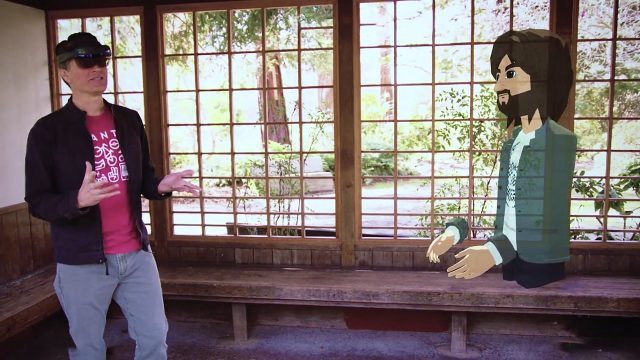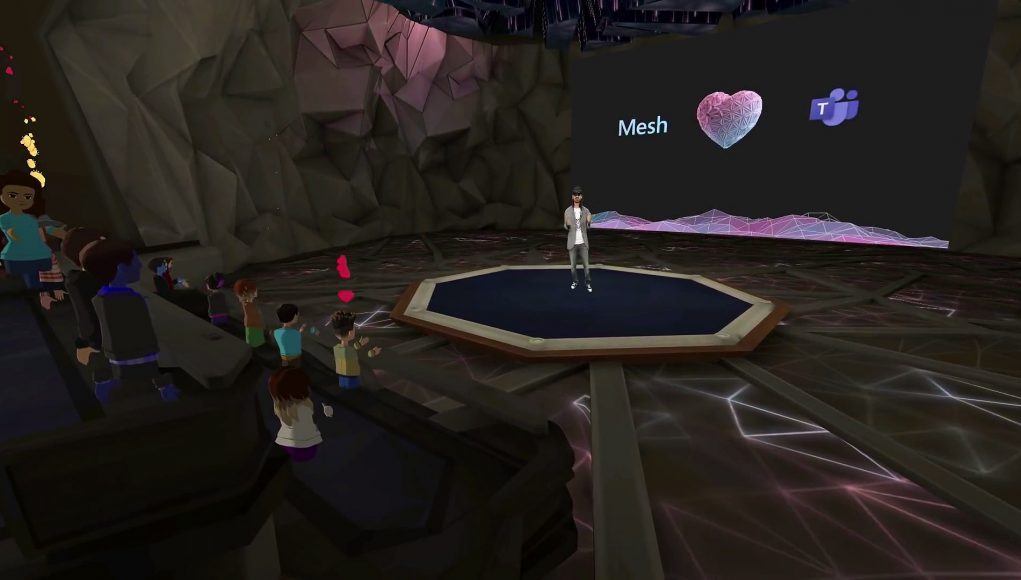A Wild Pokémon Appears
After Kipman finished some of the opening announcements, the stage transformed from a relatively enclosed room to a large, cartoony outdoor space. This set the stage for him to invite John Hanke, the CEO of Niantic (the company behind Pokémon Go), to join him.
Hanke joined the stage as an Altspace avatar, which was an interesting juxtaposition to Kipman’s real-life avatar. Because of the many technologies which can be used to represent people in VR, this sort of mixing of avatar fidelity is likely to be part and parcel of VR’s future.
Kipman and Hanke spoke of the future of social XR experiences, and how Microsoft Mesh could facilitate that future. After a brief back-and-forth, the two faded from the stage as a screen popped up to play a recorded video segment of Hanke showing off a prototype socially-enabled version of Pokémon Go running on HoloLens 2. You can watch the complete Pokémon segment here.

Funny enough, in the video segment, Hanke was his real-life self while Kipman was the one represented as a remote avatar.
Oceanographers Take to the Stage
Following a windup by Kipman, oceanographers Edie Widder and Vincent Pieribone appeared on stage as life-like representations of themselves as the stage transformed into a dark, deep sea appearance. The duo recounted some of their most memorable experiences of oceanographic discovery, with immersive visuals—like bioluminescent fish and a giant squid—floating around them to underscore their talking points.
The segment was capped off with Widder and Pieribone talking about how advancements in technology, especially 3D dat visualization, make for richer and more intuitive ways for scientists to plumb the ocean depths.
James Cameron Joins as a Guest
Celebrated filmmaker James Cameron joined Kipman on stage as a guest to talk about some of the latest work he’s been doing with submersibles and the way he and oceanographers are using immersive media to collaborate on scientific ventures remotely.
“Beaming in” from New Zealand, Cameron’s appearance on stage seemed to use the same video billboard trick as Kipman, and the two were facing each other for the conversation. As they spoke, a life-sized 3D model of a futuristic-looking remote submersible floated down from above the stage and positioned itself between the pair, bobbing gently in place as a prop relating to the conversation.
The Audience and the Stage Become One
Capping off the Ignite 2021 virtual reality keynote was the most interactive and, well… trippy part of the whole experience.
Kipman invited to the stage Cirque du Soleil founder Guy Laliberté, who first appeared as a frog that leapt out of a portal onto the stage and then transformed into an Altspace avatar version of himself.
Laliberté was there to talk about his project Hanai World, a social XR platform that aims to bring immersive components to traditionally in-person entertainment (like stage productions). After a few minutes of conversation, Kipman and Laliberté invited the audience to join them for a taste of Hanai World.
At this point, the audience was sucked into the portal and taken along a trippy wormhole of imagery before appearing on a small island surrounded by dancers. At this point, the audience had been dispersed around the island, and there was no longer any clear separation between the presenters and the audience.
Kipman and Laliberté were at the center of the island around a small fire, this time appearing as 3D volumetric captures of themselves alongside two others represented the same way. The audience meanwhile remained as their Altspace avatars.
The audience was encouraged to dance along to some singing and music as a large dome encompassed the entirety of the island with psychedelic projections of giant people projected onto it.
The keynote concluded after a few minutes of the Hanai World experience.
– – — – –
Given all the moving parts, I was surprised how seamlessly the nearly hour-long experience turned out to be. I’ve attended plenty of virtual reality presentations, but nothing nearly this ambitious.
It was clear from the presentation that Microsoft believes that part of its role is to inspire the imagination of the audience with what immersive technology could mean for the future. But far more than the overly-produced marketing videos that Microsoft showed throughout, it was the successful execution of the virtual reality keynote itself that was the most inspiring thing the company showed. After all, there I was, sitting in the virtual audience and experiencing this future first hand.







